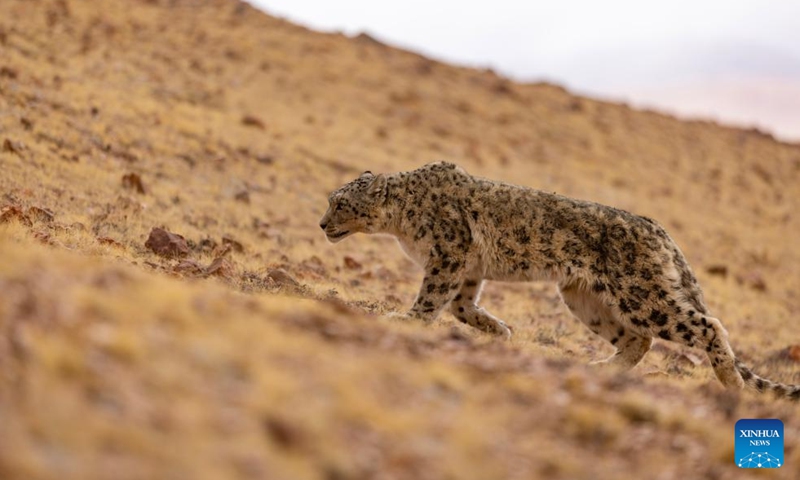Population of snow leopards in Qinghai reaches 1,200, signaling key progress in endangered species protection

This photo taken on May 7, 2024, shows a released snow leopard at Changtang National Nature Reserve, southwest China's Xizang Autonomous Region. An adult snow leopard broke into a sheepfold and killed four sheep in Nyima County in Xizang on Sunday night and was captured by the local wildlife conservation department the next early morning. The snow leopard was released into the wild at Changtang National Nature Reserve after a physical check and confirmed healthy. (Photo: Xinhua)
The population of snow leopards in Northwest China's Qinghai Province is currently estimated to be 1,200, with their distribution seen across all cities and prefectures in the province, which shows the province's significant achievement in recovering the quantity and distribution of rare and endangered species under various efforts including the establishment of a biodiversity monitoring system.
On Wednesday, which marks the International Snow Leopard Day, Qinghai's Forestry and Grassland Administration revealed that the province has been carrying out continuous work on snow leopard survey and monitoring in recent years.
In the Sanjiangyuan region, 139 snow leopards have been identified in 14 monitoring areas covering an area of 23,331 square kilometers. Conservative estimates put the snow leopard population in the region at 952.
In the Qilian Mountains, the snow leopard population is estimated to be 251 in the monitoring area totaling 15,044 square kilometers, China Central Television (CCTV) reported on Wednesday.
After years of efforts to protect their habitat, the number of snow leopards in Qinghai now exceeds 1,200, showing a significant increasing trend, according to CCTV.
Habitat is fundamental for the survival of animals and the growth of the snow leopard population is primarily the result of strengthened field monitoring and habitat protection efforts, including the expansion of protected areas and the establishment of national parks, Sun Quanhui, a scientist from the World Animal Protection organization, told the Global Times on Wednesday.
According to Qinghai Forestry and Grassland Administration, the series of ecological protection and restoration efforts, anti-poaching campaigns, as well as the system designed to monitor the wild population of snow leopards, have all contributed to the recovery trend of the snow leopard population in quantity and distribution.
According to Sun, the snow leopard is a large feline species in the Qinghai-Tibet Plateau with its high-altitude and relatively fragile ecosystems. It serves as an important indicator species for the ecological quality of the plateau environment. Strengthening the monitoring of snow leopards not only aids in their conservation but also benefits the protection of other local species, promoting the maintenance and preservation of biodiversity in the region.
On Wednesday, the Qinghai Wildlife Rescue and Breeding Center in Xining announced the success of a cataract surgery the center performed on an old female snow leopard, the second cataract surgery on a snow leopard ever conducted in China, the Global Times learned from the center on Wednesday.
The cataract surgery was conducted on August 28. With more than 50 days of postoperative care, the appearance of the snow leopard's eye has returned to normal, showing an ideal surgical outcome, with treatment expectations being met, according to preliminary assessments.
The snow leopard suspected to have been attacked by stray dogs was rescued in Qinghai in February 2022.
The predator known as the "king of the snowy mountains" typically inhabits the Qinghai-Tibet Plateau and the surrounding mountain ranges at altitudes between 3,300 meters and 5,000 meters, becoming the feline species distributed on the highest-altitude habitat in the world.
As a flagship species of the alpine ecosystems, the snow leopard is primarily distributed across 12 countries in Central Asia, with China being a key distribution area for the species.
The area of potential suitable habitat for snow leopards on the globe is approximately 3.02 million square kilometers, with about 1.82 million square kilometers located in China, accounting for 60 percent of the world's snow leopard habitat, the CNR reported on Wednesday.
Photos
Related Stories
- Rangers maintain family tradition of service
- Thousands of migratory birds rest in wetlands of Lake Gascule in NW China’s Qinghai
- Delicate thangka paintings in NW China's Qinghai
- Sichuan golden snub-nosed monkeys play at Yuhe National Natural Reserve in Gansu
- County in NW China's Qinghai advances protection, governance of Heihe River Basin
Copyright © 2024 People's Daily Online. All Rights Reserved.









